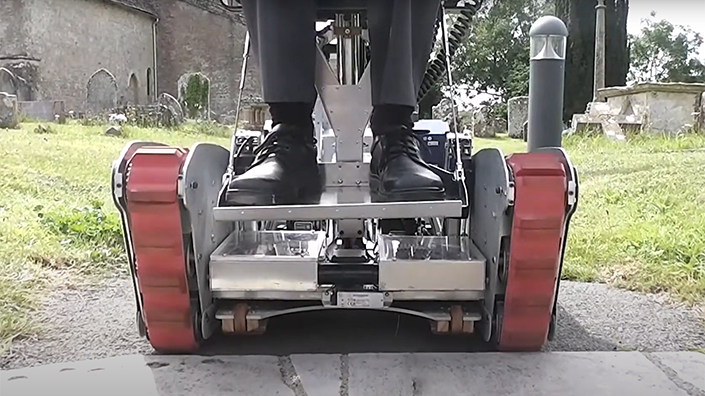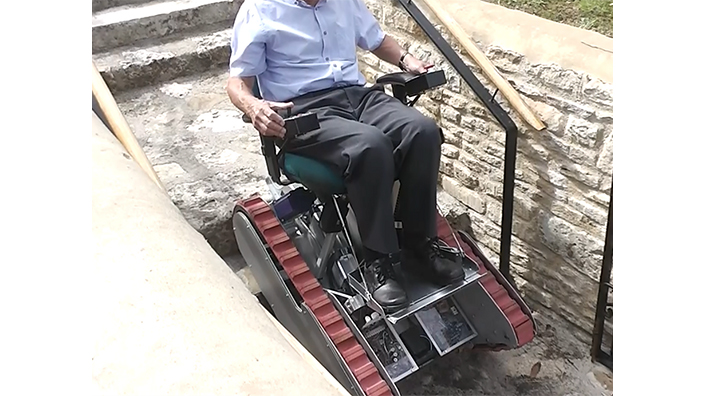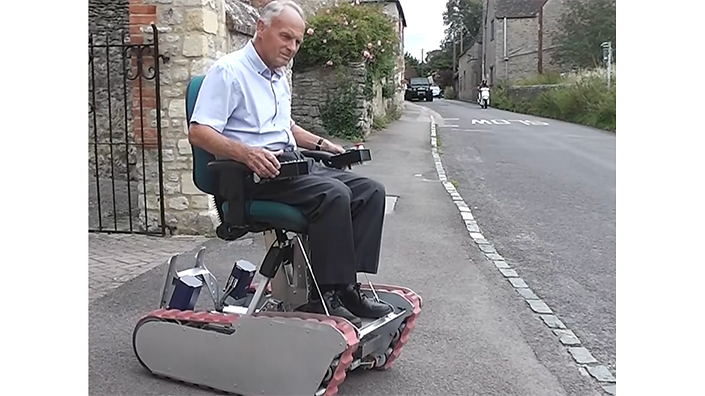IMechE fellow John Ross knows the potential of nuclear fusion. He previously worked for Tokamak Energy on the design of a magnetic system for the ST 40 spherical tokamak. That machine has since been completed, and can produce a magnetic field with a strength of 3 Tesla – 10-times more than what had been achieved previously.
For the last four years, Ross and his colleagues have been working on something completely different. Yet, for its users, it has the potential to be the most revolutionary piece of technology in their lives.
Going up
In 2016, Ross set up Igan Ltd. Standing for ‘I Go Anywhere Now’, the company has developed a new type of electric wheelchair. In fact, instead of wheels, the mobility vehicle has tank-style tracks on either side.
It is narrow enough to fit through household doors and small enough to load into cars. Its main feature, however, is enabled by the tracks and a few other engineering innovations – it is a truly ‘go anywhere’ vehicle, capable of safely climbing and descending stairs or traversing hilly terrain.

The tank-style tracks help the mobility vehicle tackle steep terrain
According to Igan, the chair can tackle “significantly sloping” terrain while keeping the user in a vertical position at all times. It manages this with an adjustable seat, which can also be raised or lowered during use to better enable conversations with others.
The unique combination of features means the mobility vehicle could restore a great deal of independence to elderly users, or grant it for the first time to younger disabled people. A user might find they can comfortably enter a previously inaccessible garden, for example, or travel further afield for domestic errands or walks with family and friends. Igan hopes it could be registered for use on the road.
Overcoming obstacles
Alan Sykes founded Tokamak Energy after coming up with a design for a spherical tokamak. He is also a friend of Ross and one of the main investors in Igan.
“John was very interested in the idea of a wheelchair because the wife of his old chum at college had mobility problems. He asked John if he could come up with a wheelchair that climbed stairs,” Sykes says.
Sykes was so impressed by John’s ideas that he and his colleagues put money in for the project. After years of work the company has created and tested a prototype, and is now drumming up support to sell the design to a manufacturer.
The development process included some ingenious solutions to the biggest challenges, with several patented features. A long vehicle is preferable when climbing or descending stairs, for example, while a shorter vehicle enables tighter turns. A retractable skid plate provides the length.
“If you come to a flight of stairs and want to go down, the wheelchair can’t suddenly go down 30º, so you need a solution,” says Sykes. “You can’t afford to pitch forward suddenly. So there is a skid plate that comes out and lowers itself down, and then continually and slowly moves the wheelchair forward to start the descent.”

The Igan vehicle descends a set of stairs
Other features include braking that adjusts to compensate for the chair’s tilt. “Braking on the level, going up or going downhill needs to be quite different, because it would be dangerous if it stopped too quickly uphill or too slowly downhill,” says Sykes. “If you run out of battery, you don’t want it to stop dead and the person to fall out.”
After testing in the summer, Ross continues to make some improvements. A new track profile could provide better grip when going up or down slopes, and might be patentable. The vehicle is slow on the stairs but faster on the flat, and Sykes says the speed could be further improved.
Cosmic experience
Throughout the project, Ross has drawn on a wealth of engineering experience from a long and varied career. In the 1990s and early 2000s he helped develop the first space-based large superconducting magnet, which was to be installed on the International Space Station to investigate dark matter, anti-matter and cosmic rays.
Igan is “almost unrelated” to his fusion and superconducting magnet work, he says. His impressive CV, which also includes C A Parsons, Brown, Boveri AG, and Oxford Instruments, nonetheless demonstrates the breadth and depth of expertise that has gone into the vehicle.

John Ross demonstrates the vehicle
“The wheelchair project used the experience gained in the last 40 or 50 years as a well-versed mechanical engineer, with electrical and cryogenic attributes,” he says. “My work on the wheelchair needed an appreciation of mechanical design, manufacturing methods, some knowledge of electrical motors, and some of control aspects and materials.”
An altruistic project
How big could the vehicle’s impact be for disabled users? Ross is clear: “Enormous.”
There are about 10m wheelchair users in Europe, with that number set to rise as the ‘baby boomer’ generation enters their 70s and 80s. The chair will come at a premium due to its high-tech features, but Ross and Sykes say the alternatives do not offer the same level of independence or comfort.
Similar climbing vehicles can only tackle kerbs, for example, while others cannot fit indoors. Another can climb stairs – but only when the user is facing backwards, something Ross was determined to avoid.
The chair will allow access to all floors of a house or flat, letting users avoid the costly and stressful move to a more accessible house or bungalow.
Sykes is fully aware of the benefits the chair could bring. “I have a relative with motor neurone disease,” he says. “They are very restricted in where they can go, on gravel or up kerbs. It would be very popular for youngsters.”
Such an ambitious and well thought out project involves significant investment of both time and money, yet Ross and his friends Sykes, Bob Anderson and Bill Huang have done it completely unpaid. “John and Bob have spent thousands of hours working on the project,” says Sykes. “It’s very altruistic to produce this.”
For some, Ross’ contribution to nuclear fusion or superconducting magnets may be his lasting legacy. But for disabled and elderly users, the independence offered by Igan could be of far greater personal importance.
Want the best engineering stories delivered straight to your inbox? The Professional Engineering newsletter gives you vital updates on the most cutting-edge engineering and exciting new job opportunities. To sign up, click here.
Content published by Professional Engineering does not necessarily represent the views of the Institution of Mechanical Engineers.